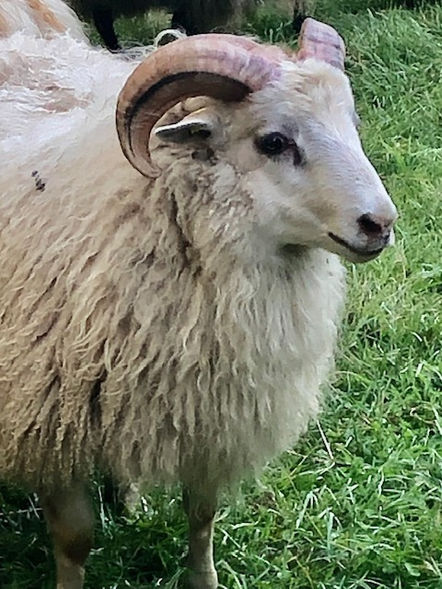Icelandic Sheep
One of the world’s oldest and purest breeds of sheep, the Icelandic sheep have been the only sheep raised in Iceland for over 1000 years. Now, they are rapidly gaining popularity in North America. They were first brought to Canada in 1985.
A member of the group of sheep known as the Northern European Short Tail sheep, the Icelandic is a colourful, medium sized, hardy, dual-coated animal that offers many qualities for the small family farm as well as commercial potential. These sheep are a fine source of meat, milk and fibre, offering an all around animal that is a pleasure to raise.
The Icelandic sheep is a medium sized sheep, ewes average 130-150 pounds and the rams 170-225 pounds. Both ewes and rams may be horned or polled. The horned rams will grow a set of curled horns similar to the wild Mountain Sheep in the Rockies. The ewes’ horns are C-shaped. The faces are open and the legs are also free of wool. The sheep are strong and healthy and prolific. They are long lived, the ewes bearing lambs into their 10th year and older. Having been raised in a grass based farming system in Iceland for the past 1200 years, they do not require expensive grain feeding to reach a respectable market weight. Most rams are sent to market at 6-8 months of age.
These sheep sexually mature early and the ewe lambs can be bred at 7-9 months of age. The ram lambs are capable of breeding at about 6 months of age, though some may be ready earlier. These ewes are very seasonal breeders, coming into estrous as the daylight shortens toward the end of October here in North America. They will continue to cycle into early spring. Most ewes here are bred in November and December.
The gestation period is typically 143-145 days, a little shorter than the average for sheep. The lambs are small at birth, generally 6-10 pounds, and their narrow heads and fine bone structure makes birthing easier. They are exceptionally vigorous at birth and are up and trying to nurse in minutes. The mothers are attentive and often have the first lamb licked off and nursing before the second is born. Twins are common in this breed and actually expected after the first lambing. The lambs are born with a good covering of very soft “poodle-like” curly fleece and tolerate the elements well. Being born in spring also means less frigid nights for lambing. The lambs grow rapidly, gaining 1/2 to 1 pound a day. These sheep are often managed in a pasture lambing situation since the lambs are born at the same time the early grass is available in many areas.
The colours of the Icelandic sheep are incredibly varied and beautiful. Six patterns are possible in this breed and an infinite range of whites, blacks, browns (moorit), and greys are seen. The sheep may also be spotted in addition to showing a pattern. These pattern genetics are well understood adding to the interest in breeding for specific colours and patterns.
The Icelandic sheep is dual-coated. The fleece is open and airy with little lanolin. A fine downy undercoat called “thel” is typically 2-3 inches long and the coarser outer coat is called “tog”. The bulky “Lopi” yarns, that are one of the most popular yarns worldwide, are spun from the two coats of Icelandic wool, and yet a prized fine lace weight yarn is also made from the fleece. The two coats can easily be separated for even more versatility. The wool from Icelandic sheep is also in demand by felters , as it is an easy and fast fibre to felt, and the natural colours are exceptionally lovely and diverse. The pelts from these sheep are soft and luxurious. The pelts feel more like fur than wool, and again the colours are outstanding. Because the number of hair follicles per inch is low, the pelts are soft and flexible.
The primary use for these sheep in Iceland has been for meat. The meat is award- winning in the European market where a lean gourmet style carcass of fine textured, light coloured and mild flavoured meat is preferred. It is an exceptional product. Being a grass fed sheep, it offers a clear advantage to the organic and natural meat producer, as well as the small farm. A ram lamb can be raised to market weight of 70-100 pounds on mother’s milk and grass/hay in 5-8 months. The carcass will dress out at 30-45 pounds, a size highly desired by the restaurant trade and gourmet markets.
A third aspect of these fine meat and wool animals is their milking ability. It was common practice in Iceland in earlier times to use the sheep as a source of milk. The milk can be used to produce excellent cheese and cultured milk products. The milk is very rich and creamy.
In North America, Icelandic sheep are registered with ISBONA through the Canadian Livestock Records Corporation, known as the CLRC. Registrations can be done via surface mail, or electronically, and requires tattooing or tagging the sheep in a manner accepted by ISBONA. As defined by the by-laws of ISBONA, the breed association recognizes the registry of Icelandic sheep only through the CLRC.






